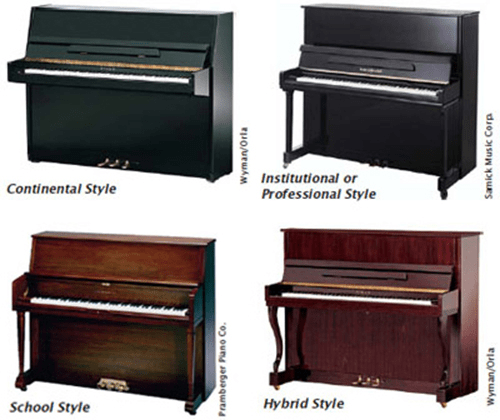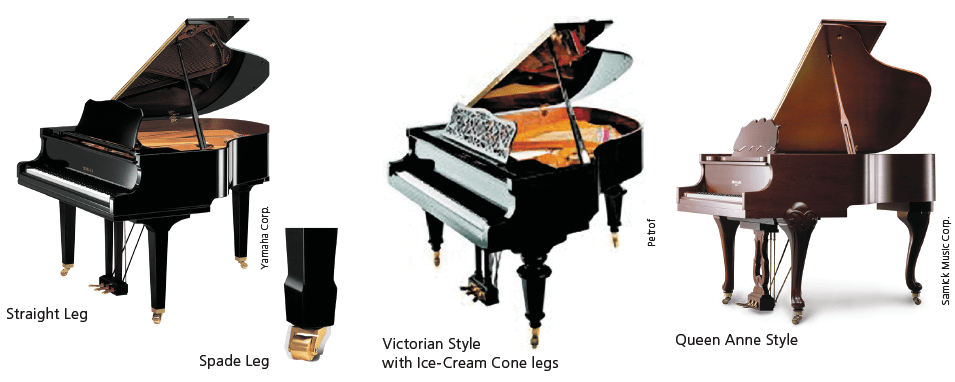Vertical pianos without front legs are known as Continental style (also called Contemporary, European Contemporary, or Eurostyle). They are usually the smallest (42 to 43 inches high) and least expensive pianos in a manufacturer's product line.
Pianos with legs supported by toe blocks are sometimes known as Institutional or Professional style, particularly when the cabinet also has little in the way of decoration or embellishment.
School pianos are a subset of the institutional-style category. Generally 45 to 47 inches in height, these are institutional-style pianos made specifically for use in school practice rooms and classrooms. They usually come equipped with long music racks for holding multiple sheets of music, locks for both the lid and the fallboard, and heavy-duty casters for easier moving. They are generally available in ebony or satin wood finishes. Sturdy and sometimes plain-looking, they are also often purchased by non-institutional customers for less furniture-conscious locations. (If you're buying a piano for an institution, please read "Buying Pianos for an Institution," elsewhere in this issue.)

Vertical pianos with free-standing legs not reinforced by toe blocks are generally known as Decorator style. Common decorator styles are Queen Anne and French Provincial, generally in cherry (or Country French in oak), all with curved legs; Italian Provincial, typically in walnut with square legs; Mediterranean, usually in oak with hexagonal legs; and Traditional, most often in mahogany or walnut, with round or hexagonal legs. Matching music racks and cabinet decoration are common furniture embellishments. Furniture-style preference is an entirely personal matter. A practical consideration, however, is that front legs not supported by toe blocks have a tendency to break if the piano is moved frequently.


Grand pianos come in far fewer styles than verticals. As you shop, it is likely you will see only a few different styles, in a number of woods and finishes.
The traditional grand piano case is likely familiar to everyone. It has rather straight or slightly tapered legs, often flaring slightly just above the floor (called a spade leg), and usually a rather plain, solid music rack.
Victorian style (sometimes called Classic style) is an imitation of a style in fashion in the late 1800s, with large, round, fluted legs and a fancy, carved music desk. Variations of the Victorian style have "ice-cream cone" or other types of round-ish legs.
As with verticals, grands also come in Queen Anne and French Provincial styles, with curved legs, and in other period styles. In addition to the leg style, these usually differ in the treatment of the music rack and cabinet embellishment as well.
Pianos come in a variety of woods, most commonly ebony (sometimes called ebonized), which is not actual ebony wood, but an inexpensive, sturdy veneer that has been painted black; as well as mahogany, cherry, walnut, and oak. Exotic woods include bubinga, rosewood, and many others, available on higher-priced uprights and grands. In pianos of lesser quality, sometimes a less expensive wood will be stained to look like a more expensive one. Pianos are also available in ivory or white, and it's often possible to special-order a piano in red, blue, or other colors.
In addition to the wood itself, the way the wood is finished also varies. Piano finishes come in either high polish (high gloss) or satin finishes. Satin reflects light but not images, whereas high polish is nearly mirror-like. Variations on satin include matte, which is completely flat (i.e., reflects no light), and open-pore finishes, common on European pianos, in which the grain is not filled in before finishing, leaving a slightly grainier texture. A few finishes are semigloss, which is partway between satin and high polish. As with furniture style, the finish is an entirely personal matter, though it should be noted that satin finishes tend to show fingerprints more than do high-polish finishes.
Most piano finishes are either lacquer or polyester. Lacquer was the finish on most pianos made in the first three-quarters of the 20th century, but it is gradually being supplanted by polyester. In my opinion, lacquer finishes — especially high-gloss lacquer — are more beautiful than polyester, but they scratch quite easily, whereas polyester is very durable. (Lacquer finishes can be repaired more easily.) Hand-rubbed satin lacquer is particularly elegant. Sometimes, when a customer desires a piano in a satin finish but the dealer has in stock only the high-polish polyester model, the dealer will offer to buff it down to a satin finish at a cost of $500 to $1,000. This is commonly done, and it works, but usually doesn't look as nice as the factory-made satin finish.
The Piano as Sculpture
Both grands and verticals are available in Designer versions, with such decorative features as inlays and marquetry, carving, wood veneer or chrome accents, burl woods, two-tone effects, decorative moldings, painting, and more. Some designer pianos are outrageous or defy categorization, while others attempt to be very "modern," or combine both the modern and the traditional.
The highest form of piano art is embodied in Art-Case pianos. These are usually highly decorated instruments, their embellishments organized around a theme and designed by a famous furniture designer, who in his work may make use of inlays, paintings, gem stones, or just about any other medium one can think of. These pianos are very expensive and considered works of art as well as musical instruments.
Under the heading "Piano Art," examples of designer and art-case pianos are scattered throughout this publication for your appreciation and amusement.